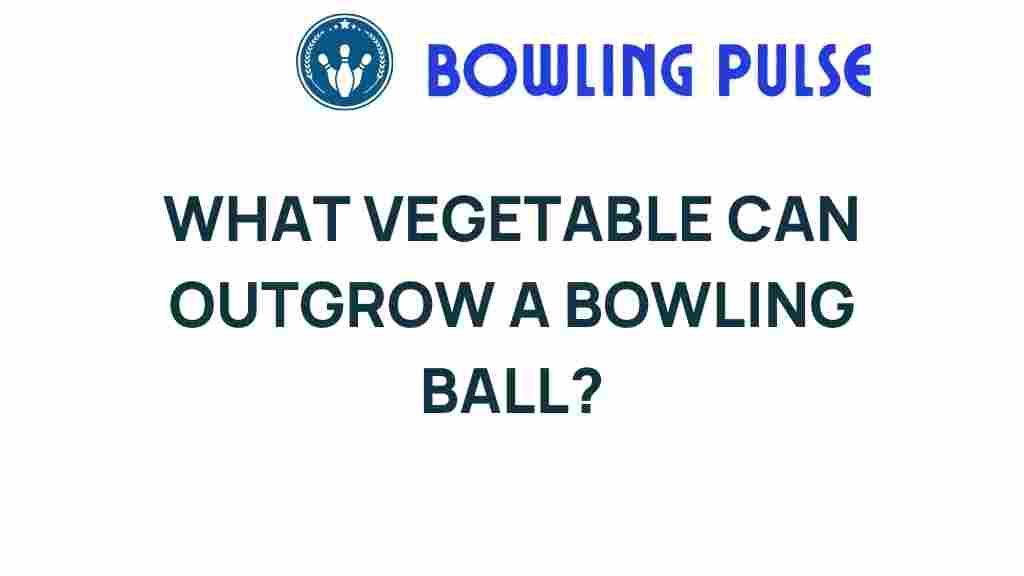The Surprising Vegetable That Can Rival a Bowling Ball in Size: Giant Vegetables in Gardening
When we think of vegetables, we often picture them as being relatively modest in size—think of the typical carrot, potato, or tomato. However, there exists a fascinating world of giant vegetables that can compete with the size of a bowling ball! These unusual produce items not only capture the imagination but also make for exciting challenges in the realms of gardening and horticulture. In this article, we will explore the secrets of growing giant vegetables, how to participate in competitions, and the joy of cultivating these extraordinary specimens.
The Allure of Giant Vegetables
Giant vegetables have become a sensational trend among gardening enthusiasts and horticulturists alike. The thrill of growing a colossal pumpkin or a gigantic cabbage is a compelling reason for many to engage in gardening. These vegetables often steal the spotlight at county fairs and competitions, showcasing the hard work and dedication of their growers.
What Makes Vegetables Grow So Large?
Several factors contribute to the growth of giant vegetables:
- Genetics: Many giant vegetables are bred specifically for size. Seeds from these specially cultivated plants can produce extraordinary results.
- Soil Quality: Nutrient-rich, well-drained soil is essential for optimal growth. The right balance of nitrogen, phosphorus, and potassium can make all the difference.
- Watering Techniques: Consistent watering helps maintain plant health and promotes maximum growth.
- Sunlight: Proper sunlight exposure is crucial. Most giant vegetables thrive in full sun, needing at least 6-8 hours per day.
- Pest and Disease Control: Keeping plants healthy and free of pests ensures they can grow to their full potential.
Step-by-Step Guide to Growing Giant Vegetables
If you’re intrigued by the idea of growing your own giant vegetables, follow these steps to get started:
1. Choose Your Vegetable
Some of the most popular choices for giant vegetable growing include:
- Giant Pumpkins
- Giant Tomatoes
- Giant Cucumbers
- Giant Carrots
- Giant Cabbages
Research which vegetables are best suited for your climate and soil type.
2. Select the Right Seeds
Look for seeds from reputable sources that specialize in giant vegetable varieties. This ensures that you have the best chance of growing an impressive specimen. Many competitions have specific seed recommendations.
3. Prepare the Soil
Preparation is key to producing giant vegetables. Follow these soil preparation techniques:
- Test Soil pH: Aim for a pH between 6.0 and 7.0.
- Add Organic Matter: Incorporate compost or well-rotted manure to enhance soil fertility.
- Till the Soil: Loosen the soil to improve drainage and root penetration.
4. Planting Your Seeds
Plant your seeds according to the specific guidelines for each vegetable type. Generally, it’s best to sow seeds in late spring once the risk of frost has passed.
5. Watering and Fertilizing
Establish a consistent watering schedule. Giant vegetables require substantial water without becoming waterlogged. Use a balanced fertilizer to provide essential nutrients throughout the growing season.
6. Monitor Growth and Care
Keep an eye on your plants for signs of pests or disease. Regularly check for:
- Wilting leaves
- Discoloration
- Insect infestations
7. Harvesting
Timing is crucial when it comes to harvesting giant vegetables. Monitor their size and maturity, and be prepared to harvest when they reach their peak size and ripeness.
Troubleshooting Tips for Growing Giant Vegetables
Even seasoned gardeners can face challenges when growing giant vegetables. Here are some common issues and solutions:
Pest Problems
Problem: Pests such as aphids and beetles can damage your plants.
Solution: Use organic insecticides or introduce beneficial insects like ladybugs to control pest populations.
Fungal Diseases
Problem: Fungal diseases can affect giant vegetable plants, especially in humid conditions.
Solution: Ensure proper air circulation and avoid overhead watering. Use fungicides if necessary.
Insufficient Growth
Problem: Your vegetables may not be growing as large as expected.
Solution: Reassess your soil quality, watering schedule, and sunlight exposure. Make adjustments as needed.
Participating in Competitions
One of the most exciting aspects of growing giant vegetables is the opportunity to participate in competitions. Here’s how you can get involved:
1. Find Local Competitions
Research local fairs and events that host giant vegetable competitions. Many regions have annual events where growers showcase their largest produce.
2. Understand the Rules
Each competition will have specific rules regarding the types of vegetables allowed, size measurements, and judging criteria. Familiarize yourself with these regulations before entering.
3. Prepare for Judging
Presentation is key in competitions. Ensure your giant vegetables are clean and free of blemishes. Consider how you will display them to catch the judges’ eyes.
4. Network with Other Growers
Joining a community of fellow giant vegetable growers can provide valuable tips and encouragement. Share experiences and learn from each other’s successes and failures.
Conclusion
The world of giant vegetables is not only captivating but also offers a rewarding challenge for any gardener or horticulturist. By understanding the unique requirements for growing these massive specimens and participating in competitions, you can experience the joy of cultivating extraordinary produce. Whether you’re aiming for the largest pumpkin or the heaviest cabbage, the process of growing giant vegetables can be both fun and fulfilling. Embrace the challenge and become a part of this unusual and exciting gardening trend!
For more tips on gardening and horticulture, consider visiting Gardening World. To learn more about giant vegetable competitions, check out Giant Vegetable Growers Association.
This article is in the category Techniques and created by BowlingPulse Team
